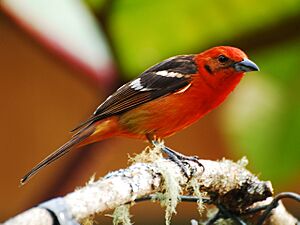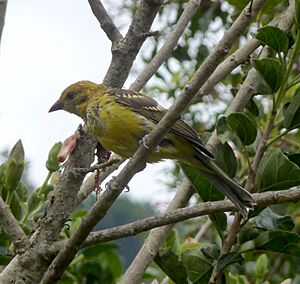Flame-colored tanager facts for kids
Quick facts for kids Flame-colored tanager |
|
|---|---|
 |
|
| Male | |
 |
|
| Female | |
| Conservation status | |
| Scientific classification | |
| Genus: |
Piranga
|
| Species: |
bidentata
|
 |
|
The flame-colored tanager (Piranga bidentata) is a colorful songbird found in the Americas. It used to be called the stripe-backed tanager. This bird belongs to the Cardinalidae family, which includes cardinals and grosbeaks.
You can find flame-colored tanagers from Mexico through Central America all the way to northern Panama. Sometimes, they even visit the United States. There are four different types, or subspecies, of this bird. Flame-colored tanagers are about 18 to 19 centimeters (7 to 7.5 inches) long. Male birds are mostly red-orange, while females are more yellowish-orange.
Contents
About the Flame-Colored Tanager
How Scientists Named It
An English scientist named William Swainson first described the flame-colored tanager in 1827. He studied a bird from Mexico. Later, another scientist thought a similar bird was a different species. But by the late 1800s, most scientists agreed they were the same kind of bird.
For a long time, the flame-colored tanager and other birds in its group were thought to be "true" tanagers. But around 2008, scientists used mitochondrial DNA (a special kind of genetic material) to learn more. They found that these birds are actually part of the cardinal family. This means they are more closely related to cardinals than to other tanagers.
Different Kinds of Flame-Colored Tanagers
There are four recognized subspecies of the flame-colored tanager:
- Piranga bidentata bidentata
- P. b. flammea
- P. b. sanguinolenta
- P. b. citrea
What Does It Look Like?
The flame-colored tanager is about 18 to 19 centimeters (7 to 7.5 inches) long.
Male vs. Female Birds
Male birds have a red-orange head and belly. This color becomes more yellow near their tail. They also have a brown patch under their eye, from their beak to behind their eye. Their back is a dusky (dark) orange with a hint of olive green.
Female birds have a similar pattern. But their head and belly are yellow, and their back is olive green with black streaks.
Subspecies Colors
- The male P. b. flammea is a lighter red-orange than the main type.
- P. b. sanguinolenta is bright red to orange-red on its head and belly.
- P. b. citrea is paler and more orange underneath compared to the main type.
Where Do They Live?
Flame-colored tanagers live in different areas depending on their subspecies:
- P. b. bidentata lives mainly in western Mexico. It can be found from Sonora and Chihuahua states south to Guerrero. Sometimes, it visits southern Arizona or western Texas in the United States.
- P. b. flammea lives in Mexico's Nayarit state and the Islas Marías.
- P. b. sanguinolenta is found from eastern Mexico south through Guatemala, Honduras, and El Salvador. It also lives in north-central Nicaragua.
- P. b. citrea lives in Costa Rica and western Panama.
These birds like to live in the tops of trees in humid montane forests (mountain forests). They also live in large trees in open areas like pastures, coffee farms, and gardens. In many places, they live in open oak and pine-oak forests.
They are usually found in mountains. In Mexico, they live from about 800 meters (2,600 feet) up to the treeline. In Panama, they live at 1,200 meters (3,900 feet) and higher. They mostly stay in one place, but some might move to lower areas in winter. Birds seen in the United States are usually just visiting before or after breeding. A flame-colored tanager was even seen in southeast Wisconsin in April 2023!
How Do They Behave?
What They Eat
Flame-colored tanagers eat small arthropods (like insects and spiders) and different kinds of berries. They usually look for food alone or in pairs. But sometimes, they join groups of different bird species that are foraging together.
They mostly hunt for food in the treetops. However, they can also fly out to catch insects in the air. Sometimes, they even go closer to the ground to pick fruit. There have been reports of them ambushing swarms of army ants that are carrying wasp larvae and pupae. They eat both the ants and the wasps!
Building Nests and Raising Young
The flame-colored tanager builds a nest that looks like an open cup. It's made of rough materials and lined with fine grass. They can build their nests in thick leaves or in single trees or bushes in more open areas. They have been seen breeding in April and May.
Their Calls and Songs
The flame-colored tanager's song sounds musical. It's often described as "chewee-very-vire, chewee-very-vire-very, cheery-cheweea." Their call sounds like "per-dick" or "chi-dick."
How Are They Doing?
The IUCN (International Union for Conservation of Nature) has said that the flame-colored tanager is a species of "Least Concern." This means they are not currently in danger of disappearing. These birds live in several protected areas. They are also not as easily bothered by changes in their environment as many other bird species.


